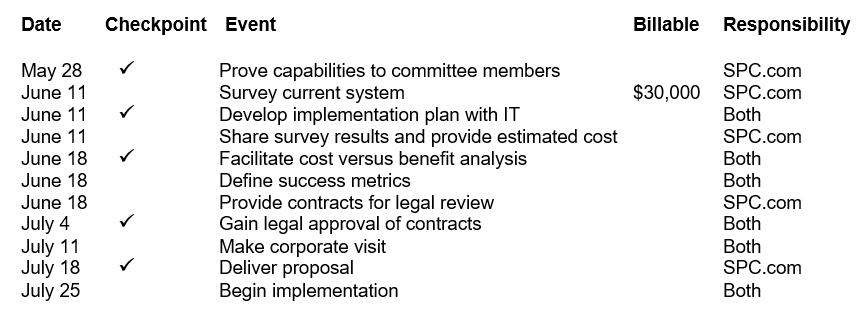Westside Toastmasters is located in Los Angeles and Santa Monica, California
Keeping Committees on Track
After obtaining consensus from the committee that the value of the potential solution warrants further investigation, there is a great chance to begin qualifying the opportunity. The first thing the salesperson should ask the committee is what they would like to see in order to evaluate the offering. This will usually elicit requests for demonstrations, site surveys, proposals, and so on. These are things that will take a sales organization a great deal of time and effort. Conservative mainstream-market buyers are also apt to ask for things a salesperson does not want (or lacks the authority) to commit to. Examples would be a money back guarantee, a lengthy free trial with no exposure, and the like. While early in a company's history salespeople may have to make concessions, as the offering matures and an installed base has been established, these requests become unreasonable. How does a salesperson respond?
One option is to take them head on, potentially responding, "We would never be willing to do that for you." In light of the fact that you've just gotten consensus to continue with considering your offerings, this represents an inopportune time to take such a hard stance. Keep in mind that you have a decision maker or makers with their subordinates in a meeting. It is likely that the senior executive wants to flex his or her muscles on a salesperson. An alternative is to merely acknowledge you've heard the request without agreeing or disagreeing.
Once the prospect has had an opportunity to respond to what the management would like to see in order to evaluate your offerings, the salesperson now has a chance to share an example of a Sequence of Events template showing typical steps previous buyers have taken on the way to making a decision on the offerings. Hopefully, this can serve as an outline for a final agreement on the steps and an approximate timeframe for the buyer's arriving at a decision. A sample is shown in Figure 13-1.
The salesperson can end the meeting by disarming any misconceptions in the event the committee has asked for things that he or she cannot commit to by thanking everyone for their time and indicating he or she will take the list back to the office and propose what he or she feels is the best way to proceed. If it is clear there is a single decision maker, the suggestion would be to commit to sending a draft copy to that person for review. After that step, any necessary changes could be made prior to copying the other members of the buying committee.
After negotiating the internal resources the company is willing to commit, the salesperson can send a cover letter and draft copy of the Sequence of Events. A phone call or meeting to follow up should be scheduled with the decision maker, to ensure that the person has had a chance to review the document. The salesperson will then ask what, if any, changes are necessary. At this stage, any unreasonable requests (i.e., a money back guarantee) would be notable by their absence in the draft of the Sequence of Events. This means one of two things will happen. One possibility is that the buyer will not raise that point, in which case you can proceed. The other would be for the decision maker to challenge the fact that the money back guarantee was not offered.
The salesperson could then ask the reason for wanting a guarantee. It is likely that the buyer will explain that it is to mitigate risks associated with the decision. At this stage, the salesperson (if this is not one of your very first customers) could respond that because fifty-three other companies have already implemented this application, the company would not be in a position to offer a guarantee, but the prospect can visit one of the company's customers who has already successfully implemented. If the buyer insists on a guarantee, the salesperson may have to determine if this is a showstopper, in which case the buying cycle may come to a grinding halt. While this is not the desired result, most would agree that it is better to find out now rather than at the end of the sales cycle. Bad news early is good news.
When the salesperson calls to follow up, it is a bad sign for a decision maker to agree to the Sequence of Events without requesting changes. This would be a sign that either the document hadn't been reviewed or the prospect was taking the commitment lightly. The correct response is to change dates or challenge some items. Your objective is to be able to remove the word DRAFT from the document, but it is most effective if the buyer makes changes because then he or she takes some ownership in the buying cycle. Some of our clients purposely leave some dates blank so the buyer is forced to make changes.




